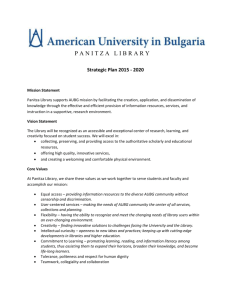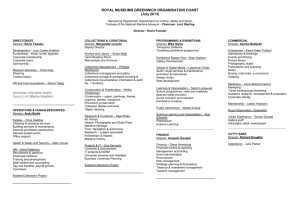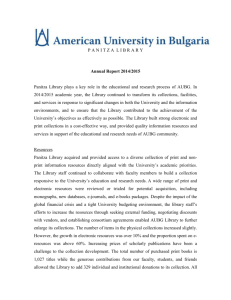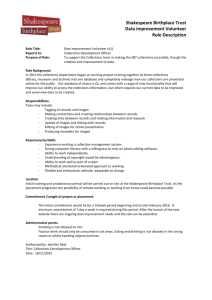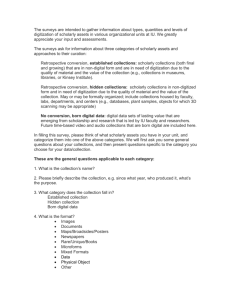Action Plan 2015/2016
advertisement
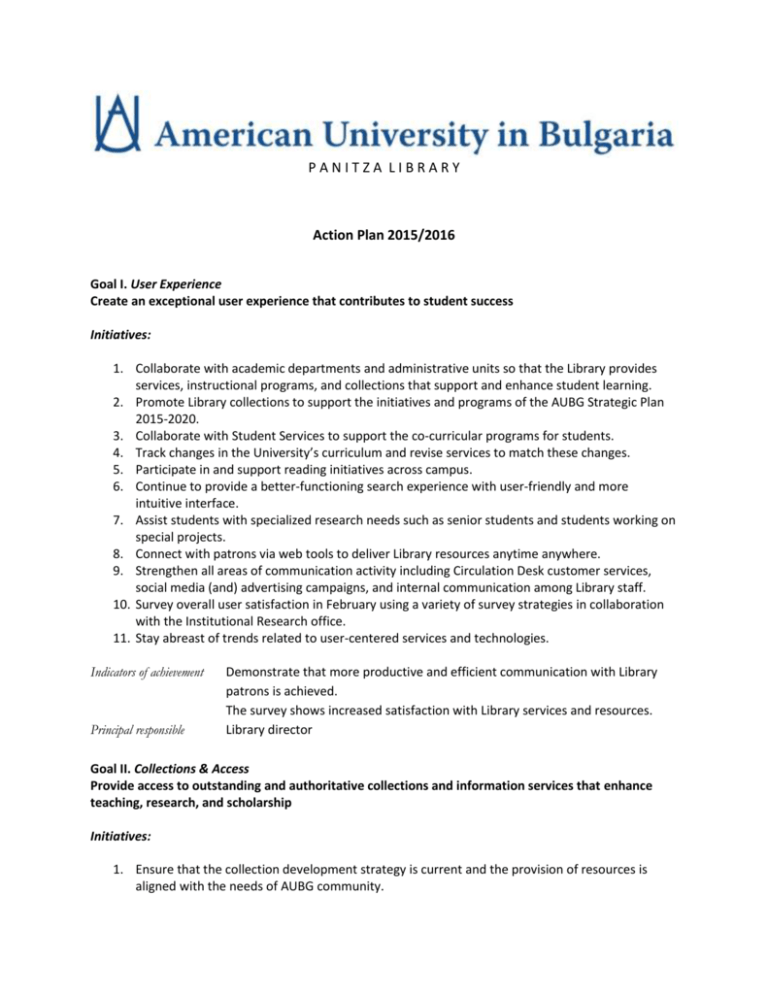
PANITZA LIBRARY Action Plan 2015/2016 Goal I. User Experience Create an exceptional user experience that contributes to student success Initiatives: 1. Collaborate with academic departments and administrative units so that the Library provides services, instructional programs, and collections that support and enhance student learning. 2. Promote Library collections to support the initiatives and programs of the AUBG Strategic Plan 2015-2020. 3. Collaborate with Student Services to support the co-curricular programs for students. 4. Track changes in the University’s curriculum and revise services to match these changes. 5. Participate in and support reading initiatives across campus. 6. Continue to provide a better-functioning search experience with user-friendly and more intuitive interface. 7. Assist students with specialized research needs such as senior students and students working on special projects. 8. Connect with patrons via web tools to deliver Library resources anytime anywhere. 9. Strengthen all areas of communication activity including Circulation Desk customer services, social media (and) advertising campaigns, and internal communication among Library staff. 10. Survey overall user satisfaction in February using a variety of survey strategies in collaboration with the Institutional Research office. 11. Stay abreast of trends related to user-centered services and technologies. Indicators of achievement Principal responsible Demonstrate that more productive and efficient communication with Library patrons is achieved. The survey shows increased satisfaction with Library services and resources. Library director Goal II. Collections & Access Provide access to outstanding and authoritative collections and information services that enhance teaching, research, and scholarship Initiatives: 1. Ensure that the collection development strategy is current and the provision of resources is aligned with the needs of AUBG community. 2. Increase multimedia, streaming videos, as well as electronic resources and gradually switch from print to digital formats. 3. Continuously evaluate and analyze Library collections, using OCLC’s collection analysis tool with focus on the economics literature. 4. Compare our collection to peers from AMICAL institutions and analyze results. 5. Identify and bridge gaps in collections through new acquisitions. 6. Weed Library materials not relevant to the curriculum. 7. Explore the possibility of applying PDA (patron-driven acquisition) model for selection of new electronic books. 8. Reshape the process of online databases selection and apply new ways to improve the management of electronic resources. 9. Continue the implementation of the Resource Description Access (RDA) cataloging standard. 10. Coordinate the project of relocation of books included in the storage collection – call numbers E, F, G. 11. Select, install, implement, and maintain software to improve remote access to e-resources. 12. Maintain a user-centered, approachable, and proactive reference presence in the Library that is collaborative and instructional. 13. Use a variety of levels of Library staff to provide reference and information services during all working hours of the Library. 14. Emphasize on research assistance to support faculty. 15. Provide excellent interlibrary loan services as both a borrower and a lender. 16. Update the bib records in AMICALCat. 17. Maintain good order of collections. 18. Continue to explore, develop, and evaluate Library 2.0 technologies for the provision of information services. 19. Ensure policies and procedures support user-friendly access to resources and services. Indicator of achievement Principal responsible Increase in monograph and electronic resources. Increase in number of students using reference service. Implementation of the latest information technologies in the Library services. Provision of more convenient access to electronic resources. Library director, head of access services, collection development group Goal III. Teaching and Learning Create teaching and learning programs and resources for the acquisition of information literacy skills that go beyond academia Initiatives: 1. Provide a basic level of information literacy instruction to all students in the Common First-Year Experience and in ENG102 courses. 2. Provide an appropriate level of information literacy instruction in all courses that require solid research. 3. Collaborate with academic departments, the General Education Committee, and the Dean of Faculty to design and implement information literacy instruction for each major. 4. Develop and maintain strong liaisons between the Library and each academic department for the provision of course-related information literacy instruction. 5. Collaborate with faculty to design meaningful assignments that integrate Library and information technology resources into courses. 6. Strengthen orientation and training for new-coming faculty. 7. Create interactive instructional tutorials and post them on the website. 8. Develop subject guides using the web tool LibGuides for the major academic disciplines. 9. Provide instruction on citation styles and standards. 10. Educate Library users on “fair use” of copyrighted materials. 11. Analyze the result of the use of Imagine Easy Academy online instruction platform and decide whether to replace it with Research Companion. 12. Develop a method to assess students’ acquisition of information literacy skills across classes. Indicators of achievement Principal responsible Increase the efficiency of Library instruction classroom sessions. Increase in the number of students that have been trained. The exercises and tests conducted to assess the learning outcomes should show that the Library resources are used effectively and efficiently by the majority of students. Faculty and students respect the legal and moral issues of using information. Information Literacy Librarian Goal IV. Outreach and Marketing Market the Library’s services and resources to both University and external partners Initiatives: 1. Develop and implement a Library marketing plan. 2. Design promotional materials. 3. Continue Book of the Week initiative as well as displays of books related to a given event or author. 4. Promote actively the electronic resources to increase their usage. 5. Organize a competition for The Best Library Patron with incentive awarding. 6. Organize Friends of the Library initiative. 7. Foster and maintain consortia relationships at the local, state, regional, and national levels. 8. Participate in Standing and Ad-Hoc Committees that are pertinent to the Library’s mission. 9. Collaborate with University Events Office for the organization of book presentations, readings, lectures, exhibitions, etc. 10. Arrange a Book Crossing area in the Library. 11. Communicate effectively with AUBG community. 12. Provide readers advisory services - recommendation bibliographies, list of resources, book exhibitions to celebrate important dates and events, etc. 13. Increase the Library presence in the learning management system Blackboard as additional gateway to the Library’s resources and services. 14. Continue to assess and improve the Library’s web-site as the major gateway to Library resources and services. 15. Pursue Library grant opportunities for collections, technology, and program developments. 16. Work with potential donors to increase the number of donated books. Indicators of achievement Principal Responsible Position Panitza Library as a center for learning, reading, and research. Increase the visibility of the Library and make it more distinguishable. Increase the number of donations. Library Director, Special Events Coordinator Goal V. Digital Infrastructure Increase the Library’s capacity to create, acquire, and manage digital scholarly content Initiatives: 1. Create a database of digitized students’ senior theses using DigiTool software. 2. Start the digitization of AUBG Today newsletter and the students’ publications Aspecter, Agora, Vox, AUBG Literary magazine, and Verve. 3. Plan the implementation of a pilot institutional repository. 4. Create a virtual collection of faculty development resources and make it accessible. 5. Continue the creation of a special collection of rare, valuable books and plan for their digitization. 6. Continue to implement the VIRTUA integrated library system and Chamo Discovery and upgrade it to the latest versions. 7. Collaborate with the Chief Information Officer and Computer Services to provide excellent academic computing services. Indicators for achievement Principal Responsible Archive of student research as well as historical documents of AUBG is created in formats that will be stable overtime and searchable. Library director, Library computing supervisor, head of cataloging Goal VI. Organizational Culture Expand the skills, knowledge, and engagement of all Library staff in order to provide excellent services and individual job satisfaction Initiatives: 1. Develop and maintain a highly-qualified staff that is adequate in number to provide the best Library services to users. 2. Design and implement a program of Library staff development and training. 3. Support librarians and other Library staff in continuing their own career self-improvement. 4. Support librarians in pursuing continuing education, professional involvement, and scholarship and creative work. 5. Organize ongoing internal training to all Library staff who provide reference services. 6. Provide practicum opportunities for students enrolled in library and information science education. 7. Employ a team, oriented towards collaborative engagement. 8. Participate actively in local, regional, and national library professional associations and consortia. Indicators of achievement Principal Responsible Library staff complete advanced degrees and engage in professional development. Meet the Association of College and Research Libraries standards for staffing or demonstrate that service requirements are met with existing staff. Educate/train staff to provide the best Library services to users. Enhance the Library reputation on a national scale. Library director Goal VII. Learning spaces Promote a dynamic and supportive learning environment Initiatives: 1. 2. 3. 4. Maintain physical facilities that foster studying, teaching, and research. Ensure that all Library services and facilities are accessible to all users. Add and/or replace comfortable seating throughout the Library. Strengthen the Library’s role as an intellectual center on campus by hosting lectures, presentations, readings, and exhibitions. 5. Review Library operation for energy efficiency, environmental friendliness, and sustainability. Indicators of achievement Principal Responsible Surveys show that students enjoy a comfortable and convenient learning space. Increase the number of Library visitors. Library director
